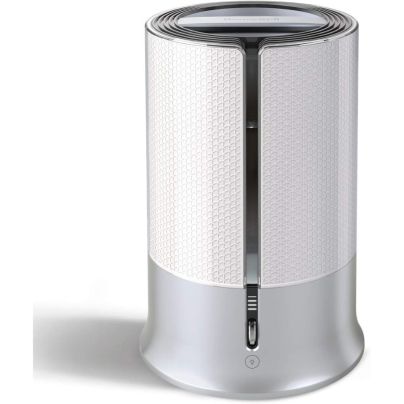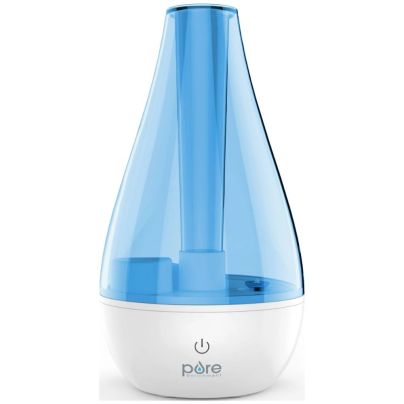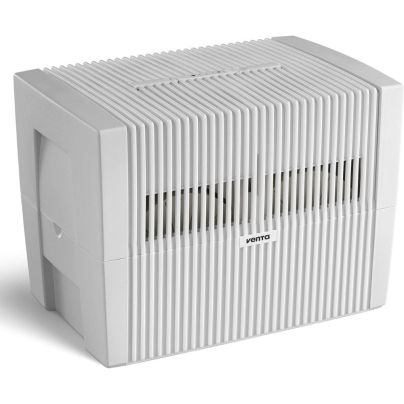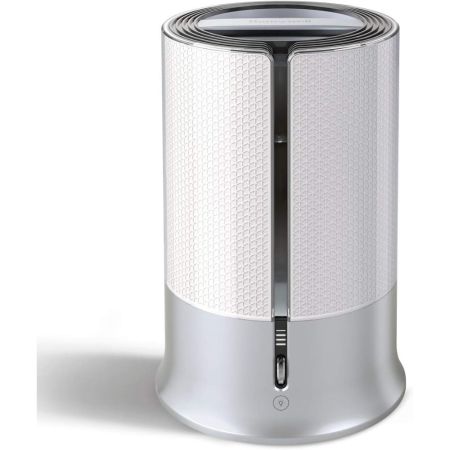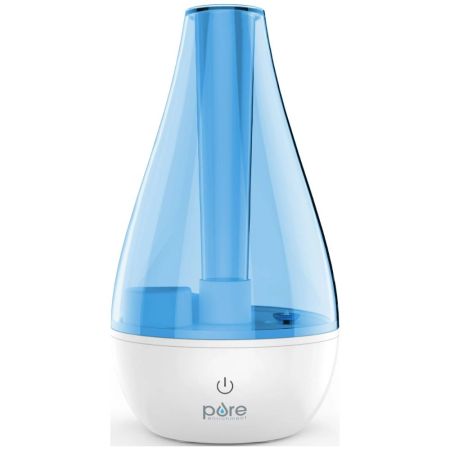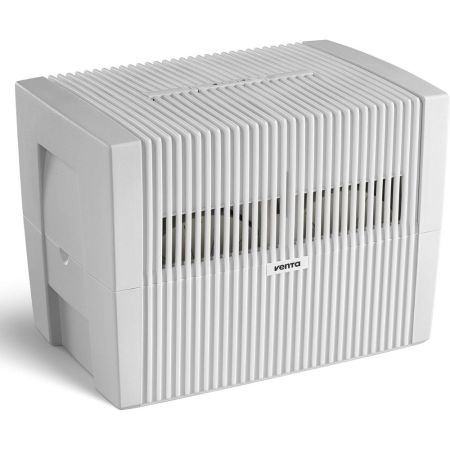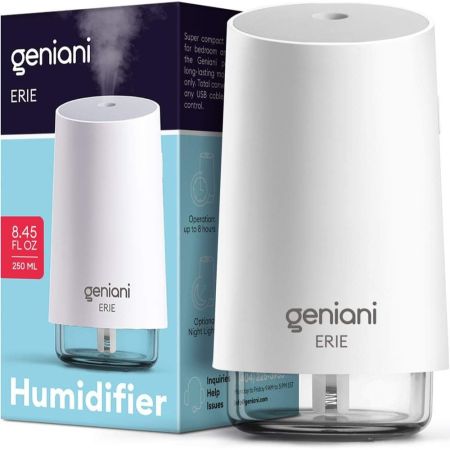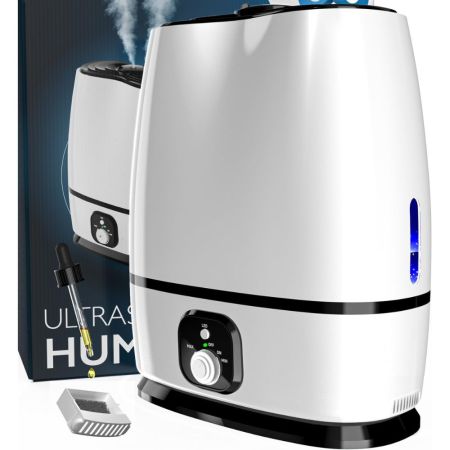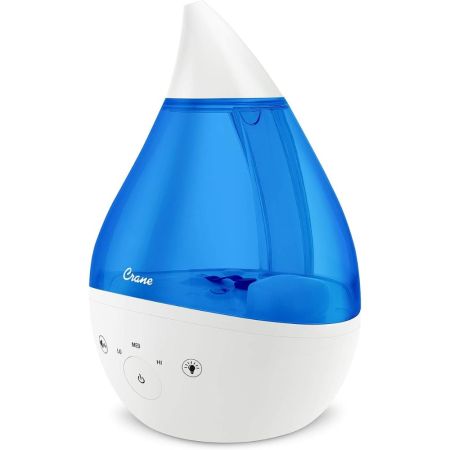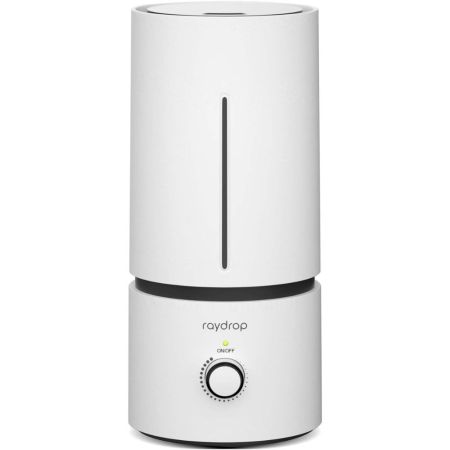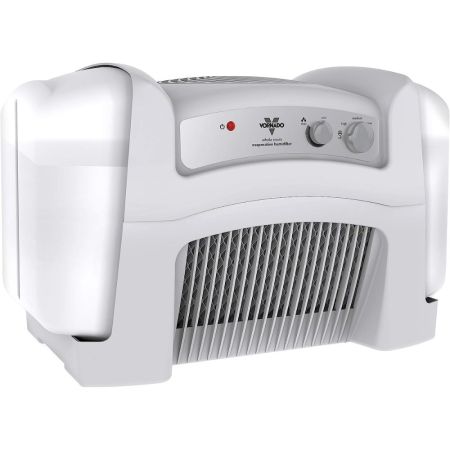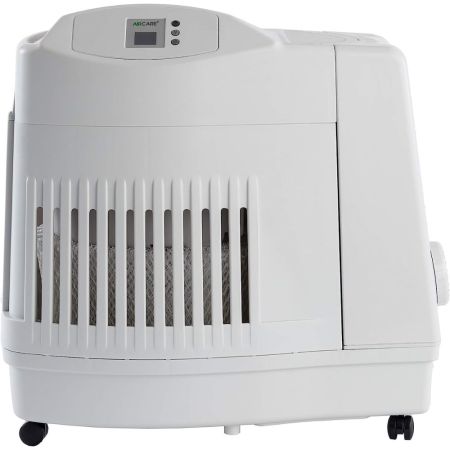We may earn revenue from the products available on this page and participate in affiliate programs. Learn More ›
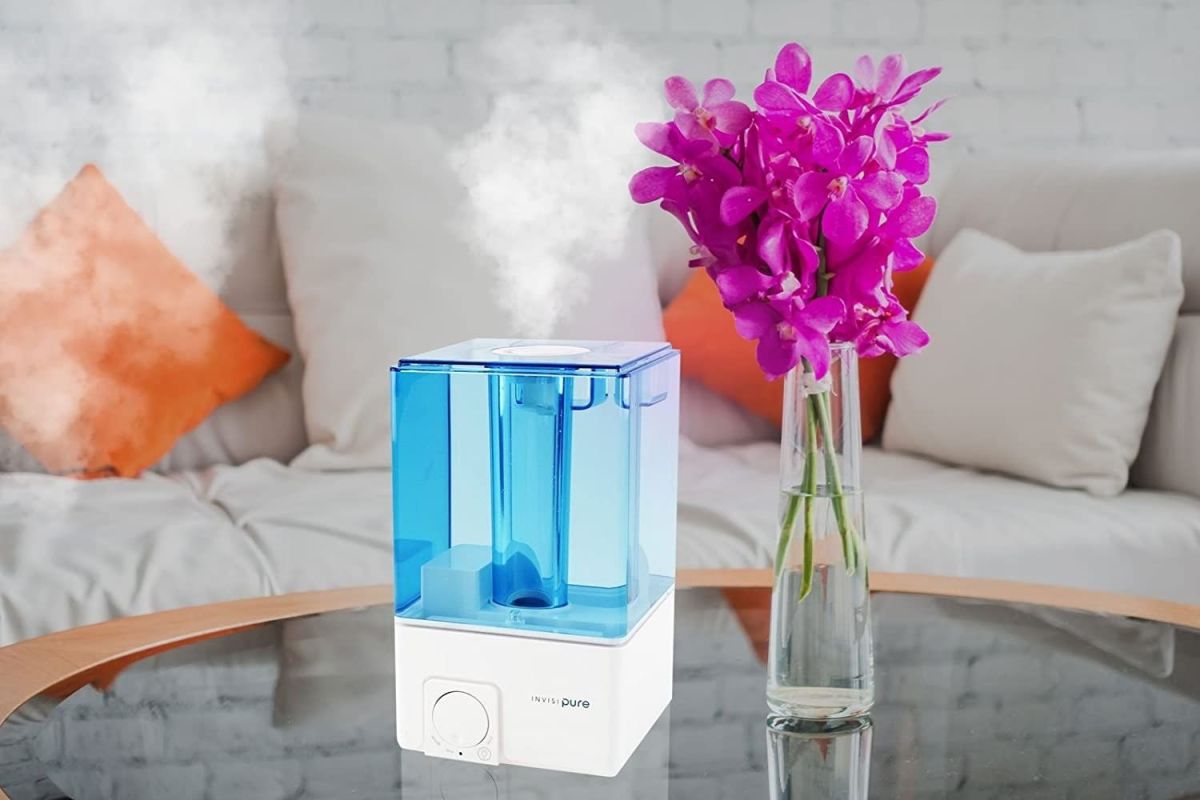
Heating and air conditioning strip a home’s indoor air of its natural humidity. The result of uncomfortable dryness leaves skin feeling dehydrated, contributes to sinus and respiratory problems, and even promotes static electricity—that annoying shock that occurs upon crossing a carpeted room and touching the television.
A little added moisture in the air helps alleviate dust mites, reduces allergy symptoms, and soothes irritated nasal passages. In addition to a handful of household hacks, residents can rely on humidifiers to help the situation. Humidifiers have been around for decades, but today’s models offer more choices than ever before. We’ve done the legwork and found out what features buyers want most in humidifiers as well as which models they rate as the best humidifiers.
Keep reading to learn all about today’s room humidifiers, hear what experts have to say about these devices, and discover why we’ve selected these as top choices, depending on a person’s individual home and needs.
- BEST OVERALL: Levoit Classic Ultrasonic Smart Humidifier
- BEST BANG FOR THE BUCK: Pure Enrichment MistAire Studio Ultrasonic Humidifier
- UPGRADE PICK: Venta Filter-Free Evaporative Humidifier
- BEST DESIGN: Honeywell Designer Series Cool Mist Humidifier
- BEST PORTABLE: Geniani Erie Portable Small Cool Mist Humidifier
- QUIETEST OPERATION: Everlasting Comfort Air Humidifier for Bedroom
- BEST FOR PLANTS: Crane 4-in-1 Drop Ultrasonic Cool Mist Humidifier
- BEST FOR SMALL ROOMS: Raydrop Cool Mist Small Room Humidifier
- BEST FOR LARGE ROOMS: Vornado Evap40 4-Gallon Evaporative Humidifier
- BEST WHOLE-HOUSE: Aircare MA Console-Style Evaporative Humidifier
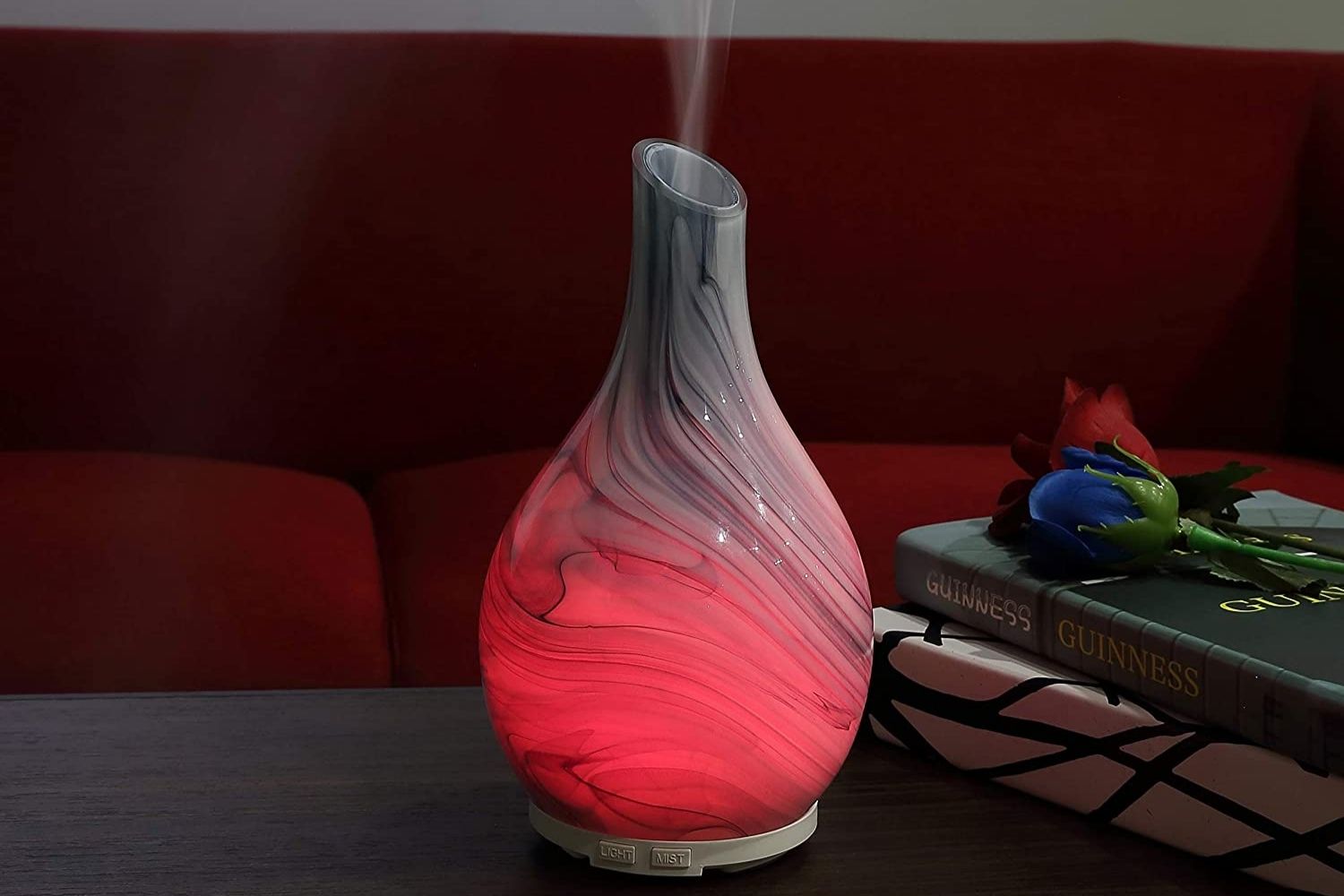
How We Chose the Best Room Humidifiers
Room humidifiers can do more than just improve the air quality. They can soothe dry skin, chapped lips, and help relieve a dry throat and common cold symptoms. However, there’s no one-size-fits-all solution, so consumers will want to check the variety available before making their choice.
During our own research, we looked at over 60 of the best room humidifiers currently available before landing on our carefully collated selection. We wanted to incorporate the various types, account for different room sizes, and choose models that were as easy to operate and maintain as possible. We looked for a range of humidifiers that would satisfy every need.
Price is always a consideration, and many of our picks offer excellent value for money. We also included a few high-end models for those who are prepared to pay a little extra for their comfort.
Evan Scobria, founder of Prime Home Humidity based in Bellingham, Washington, provides consumers with the latest information about humidifiers, dehumidifiers, and home humidity. “The mist created by room humidifiers protects wood floors and wood furniture from the damaging effects of overly dry air,” he says. In sum, the devices “are an effective remedy for low-humidity home environments.”
Our Top Picks
We considered factors such as warm versus cool mist, size, and technology to determine the best room humidifier for just about any residence.
Best Overall
Levoit Classic Ultrasonic Smart Humidifier
See ItProduct Specs
- Type: Ultrasonic
- Runtime: Up to 60 hours
- Coverage: 215 to 505 square feet
Pros
- Versatile model offers smart control to create schedules and monitor humidity
- 4 mist levels and auto mode that adjusts itself to maintain the chosen humidity
- 6-liter (1.6-gallon) water tank provides long runtimes and includes aromatherapy tray
Cons
- Faults aren’t common, but a small number of leaks have been reported
With so many quality models available, it isn’t easy picking a single best room humidifier. The Levoit Classic takes top spot for its wide-ranging feature set at a price that won’t break the bank.
A 6-liter (1.6-gallon) water tank provides a runtime of up to 60 hours in rooms from 215 to 505 square feet. It has a top opening that’s easy to fill—and easy to clean, too. It includes an aromatherapy tray for oils that can add pleasant aromas to the room and can help relieve nasal congestion or a sore throat.
There are four mist levels, an auto mode that maintains the desired humidity, and a sleep mode that turns off the display. Smart control allows schedules and timers to be set, and the Levoit Classic can integrate with Amazon Alexa or Google Assistant for voice control.
Get the Levoit room humidifier at Amazon, Walmart, or Best Buy.
Best Bang For The Buck
Pure Enrichment MistAire Studio Ultrasonic Humidifier
See ItProduct Specs
- Type: Ultrasonic
- Runtime: Up to 10 hours
- Coverage: Up to 175 square feet
Pros
- Compact model ideal for modest spaces at a very competitive price
- High and low mist settings provide up to 10 hours per refill
- Easy-to-fill top-loading model; comes with its own cleaning brush to help prevent mold
Cons
- Small tank means frequent refilling required; could be annoying for some users
The Pure Enrichment MistAire Studio humidifier is a sleek, good-looking model that is compact enough to fit on a desk, side table, or bedside cabinet. It’s an ideal solution for those who want humidification for rooms up to 175 square feet, and it comes with a budget-friendly price tag.
There are two mist settings (high and low), providing runtimes of either 7 or 10 hours. It could, for example, be used for a bedroom (it includes a night-light), then topped up and moved to a home office, kitchen, or workroom during the day. There’s an automatic shutoff to prevent damage if it runs dry.
Get the Pure Enrichment room humidifier at WalmartorTarget.
Upgrade Pick
Venta Filter-Free Evaporative Humidifier
See ItProduct Specs
- Type: Cool mist
- Runtime: None provided (see above)
- Coverage: 600 square feet
Pros
- High-capacity unit can run for more than a week before it needs cleaning
- Simple top-mounted LED touch controls offer the choice of 3 speeds
- Runs safely on tap water and doesn’t have filters to clean or change
Cons
- It’s quite a bit more expensive than the other picks on our list
This Venta humidifier uses an unusual—yet very simple—design of a disk stack running in a 3-gallon bath of water. With no wick or filters to clean or replace, it’s a very low-maintenance machine. While many standard humidifiers require cleaning every day or so, the Venta only needs to be checked every 10 to 14 days, and the process is very straightforward.
This Venta model is rated for coverage of up to 600 square feet and offers three speeds for rapid humidification if desired. The company doesn’t provide a runtime but does suggest that the water level be checked daily. Should the water run out, the machine will automatically switch itself off.
Venta says their machine naturally reduces air pollutants. Another option is to consider a combined humidifier and air purifier, devices we explored
.
Get the Venta room humidifier at Amazon, Lowe’s, or The Home Depot.
Best Design
Honeywell Designer Series Cool Mist Humidifier
See ItProduct Specs
- Type: Cool mist
- Runtime: Up to 24 hours
- Coverage: None listed (see above)
Pros
- Sleek, modern, filter-free design with 3-stage illuminated water tank window
- Ergonomic handle provides rapid access to wide tank for easy refills
- Tactile scroll wheel allows adjustment of mist output, and an aromatherapy tray is included
Cons
- At the price, we’re surprised that there’s no humidistat—the machine is either on or off
Good design is about more than visual appeal. While we expect many will find the exterior of the Honeywell Designer Series humidifier attractive, there are several valuable ergonomic and practical elements we can recommend as well.
A clever handle in the lid gives easy access to the 1.25-gallon lift-out water tank, making it easy to fill and clean. An illuminated window lets users check the water level easily with three lighting settings: bright, dim, and off. There’s also an auto shutoff if it reaches empty. Below this is a thumbwheel that allows the mist output to be adjusted to personal preference. Honeywell claims the Designer Series humidifier can run for up to 24 hours, though rather than give a specific coverage area, the machine is simply described as for medium to large rooms.
Get the Honeywell room humidifier at Amazon, Walmart (in black), or Target.
Best Portable
Geniani Erie Portable Small Cool Mist Humidifier
See ItProduct Specs
- Type: Cool mist
- Runtime: Up to 8 hours
- Coverage: Up to 65 square feet
Pros
- Compact and lightweight cordless model for humidification on the go
- Features include 1-button operation, USB charging, silent running, and night-light function
- Fits in most cup holders, so it can be used in vehicles
Cons
- It’s very popular, but fault reports suggest quality control might be hit and miss
Folks who need to humidify a variety of small spaces but only want to purchase one machine will want to take a close look at Geniani’s portable unit. It’s compact, has cordless operation, and weighs under 11 ounces. This travel-ready mini model will even fit into vehicle cup holders. USB charging can be done via a laptop, portable power pack, or household socket with an appropriate adapter.
Despite a tank that’s only 0.006 gallon, the Geniani will run for up to 8 hours. Coverage isn’t huge at 65 square feet, but it’s adequate for many modern motel rooms. It runs silently, so it won’t disturb sleep. There’s a built-in nightlight plus an auto shutdown that prevents damage if it dries out.
Get the Geniani room humidifier at Amazon or Walmart.
Quietest Operation
Everlasting Comfort Air Humidifier for Bedroom
See ItProduct Specs
- Type: Ultrasonic
- Runtime: Up to 50 hours
- Coverage: Up to 500 square feet
Pros
- Uses “whisper-quiet” motor technology, which should allow for undisturbed sleep
- Straightforward dial control offers fully variable humidification to suit individual tastes
- Includes selectable night-light, drawer for aromatherapy oils, and 360-degree mist nozzle
Cons
- Some found it awkward to fill or to carry when full without spills
It’s never easy to define how quiet something is because we all hear differently. However, we do know that ultrasonic humidifiers like this one from Everlasting Comfort are typically quieter than fan-based alternatives. Although the manufacturer doesn’t give an actual decibel level, independent figures put it at under 35 decibels, which is the equivalent of the “whisper quiet” given in the description.
This low sound level is all the more impressive given the performance provided. Variable mist output gives a runtime anywhere from 22 to 50 hours from the 1.6-gallon water tank, and it’s rated for coverage of 500 square feet. An aromatherapy oil tray lets users scent the room either purely for pleasure or to combat seasonal allergies.
Get the Everlasting Comfort room humidifier at Amazon or Walmart.
Best For Plants
Crane 4-in-1 Drop Ultrasonic Cool Mist Humidifier
See ItProduct Specs
- Type: Ultrasonic
- Runtime: Up to 24 hours
- Coverage: Up to 500 square feet
Pros
- Adjustable 360-degree nozzle can aim humidification at groups of houseplants
- 3 speed settings to adjust output, plus easy-to-monitor water level
- Included sound machine delivers a choice of white noise, rain, or ocean waves to help sleep
Cons
- Not everyone likes the sounds or color-changing night-light, but both can be turned off
Those keen on houseplants probably know that most of them love increased humidity. While tropical plants may prefer a warm mist humidifier, these devices can cause discomfort for people. The Crane ultrasonic cool mist model is a solution that will keep both plant life and human occupants happy.
The 360-degree nozzle allows humidity to be directed where it’s needed most, and three speeds deliver the desired moisture level. With its clear 1-gallon tank, the Crane humidifier can run for up to 24 hours and provide coverage for up to 500 square feet. For nighttime use, it comes with a choice of three soothing sounds, and it has a night-light that changes colors. An aroma tray is included that can accept pads or oil.
Get the Crane room humidifier at Amazon, Walmart, or Target.
Best For Small Rooms
Raydrop Cool Mist Small Room Humidifier
See ItProduct Specs
- Type: Ultrasonic
- Runtime: Up to 9 hours
- Coverage: 220 square feet
Pros
- A low-cost model that’s under 5 inches in diameter, so it’s great for small spaces
- It has an impressive runtime for its size, even on full power
- Very quiet with an easy-to-use dial that offers precise mist control
Cons
- Cannot use essential oils, and a tray is recommended on wood tables or delicate surfaces
Finding a spot for a humidifier can be a challenge in small spaces like dorm rooms or campers. This Raydrop humidifier boasts a compact design that’s only 4.7 inches in diameter, so it should be easy to find a space for it in small or cluttered spaces. It also has a noise level of just 32 decibels, which is described as very faint, so it should not disturb sleepers.
The water tank is only 0.45 gallon, but that will provide mist for up to 9 hours at the machine’s highest output setting. The revolving control dial is easy to use while still offering accurate adjustment of mist output. It is rated for coverage of 220 square feet, so it actually has the capability to humidify good-size bedroom or home office spaces. It also comes with a budget-friendly price tag.
Get the Raydrop room humidifier at Amazon or Walmart.
Best For Large Rooms
Vornado Evap40 4-Gallon Evaporative Humidifier
See ItProduct Specs
- Type: Cool mist
- Runtime: Up to 24 hours
- Coverage: Up to 1,000 square feet
Pros
- Uses a vortex action to spread humidity evenly throughout the entire room
- 3-speed fan with built-in humidistat for “set-it-and-forget-it” convenience
- 4-gallon tank capacity allows for all-day use, even in large spaces
Cons
- It’s quite a bulky unit, and a few owners have reported humidistat faults
Vornado is one of the leading names in air movement, from fans and heaters to air purifiers and humidifiers. The Evap40 provides impressive performance for spaces of up to 1,000 square feet. Not surprisingly, it’s a little more expensive than most of our other top picks, but considering the coverage provided, we think it represents a good value.
The Vornado Evap40 has a unique vortex action that spreads humidity evenly throughout the room. Two 2-gallon water tanks give up to 24 hours of continuous humidity, and they lift out for easy refilling and cleaning, without moving the main unit. There is a three-stage fan and a rotary humidistat allowing users to set precise levels. Two antimicrobial-treated wicks are used with this model, and they must be replaced every 4 to 8 weeks.
Get the Vornado room humidifier at Amazon or Walmart.
Best Whole-house
Aircare MA Console-Style Evaporative Humidifier
See ItProduct Specs
- Type: Cool mist
- Runtime: Up to 36 hours
- Coverage: Up to 3,600 square feet
Pros
- High-performance model for large spaces with casters for easy mobility
- Adjustable humidistat and 4 fan speeds for precise setting of desired humidity
- Helpful visual alerts for when to refill the tank and change the wick
Cons
- Area to be humidified must be contiguous, and wicks have modest lifespan
There are two types of whole-house humidifiers. The first needs to be
, so fitting will need to be considered in addition to the cost of the unit. The second type are console-style models, like this Aircare MA, which offers coverage of up to 3,600 square feet (of contiguous space) and can run for 36 hours between refills. It’s quite large, but casters make it easy to move around, and the 3.6-gallon water tank lifts out for easy refilling.
Control is via adjustable humidistat and four-speed fan allowing fine control over humidity levels. There are useful indicators for when the tank is empty and the wick needs changing. A demineralization cartridge is also included to provide water that is as free from contaminants as possible.
Get the Aircare room humidifier at Amazon, The Home Depot, or Walmart.
Jump to Our Top Picks
What to Consider When Choosing a Room Humidifier
Getting the best room humidifier for your needs involves considering the differences between warm mist and cool mist models, room size requirements, humidistat features, ultrasonic technology, and cleaning considerations. Additionally, for households with young members, it’s essential to explore child-safe options to ensure a secure and family-friendly choice.
Warm Mist vs. Cool Mist Humidifiers
Both cool and warm mist humidifiers add much-needed moisture to dry indoor air, with slight differences:
- A standard warm mist humidifier brings water to a boil to inject the room’s air with a little extra moisture. The high heat reduces the risk of bacterial transmission, leading it to be considered slightly healthier. Warm mist humidifiers are also typically quieter to operate since steamy mist naturally rises, eliminating the need for an internal fan. They do require additional cleaning because the boiling process leaves behind mineral deposits.
- A cool mist humidifier (also called evaporative) uses a fan to blow air through a damp wick, so it can be noisy when it turns on. Cool mist humidifiers are preferable to warm mist humidifiers in homes with small children since there is no danger of burning little fingers.
Ultrasonic Technology
Ultrasonic humidifiers can disperse a warm or a cool mist, or both. The cool mist option is more common, but some models include an internal heater that facilitates a cool mist in the summer and warm mist in the winter. Instead of utilizing a strong fan, as a standard cool mist humidifier might, an ultrasonic humidifier breaks up water droplets into mist using a ceramic diaphragm that vibrates at a frequency too high to be audible to the human ear. Best of all, most ultrasonic humidifiers are whisper quiet, so they won’t interfere with sleep.
Size
A humidifier that is too small may not be sufficient, while one that’s too large could add so much moisture into the room that droplets appear on furniture and other surfaces. Fortunately, humidifiers are rated by the intended room size.
- A small room humidifier effectively treats rooms with less than 400 square feet of floor space. They are often portable and lightweight, making them a good choice for bedrooms, nurseries, kitchens, and other small spaces.
- Medium-size room humidifiers treat rooms between 400 and 900 square feet and are only semiportable.
- For a room with 1,000 square feet or more, look for a large room humidifier. Large room humidifiers feature bigger water reservoirs and are stationary.
Humidistat
A humidistat is a concept similar to a thermostat on a heater, except a humidistat is used to set the desired humidity. The humidifier will then turn itself on and off automatically to maintain that level. Many room humidifiers have a humidistat, though by no means all. Cheaper models may just pump out moisture at a preset level and need to be turned on and off manually. Unfortunately, this isn’t convenient for rooms that are unattended and can lead to over or under humidification.
Often the humidistat is a sensor with a simple dial, and some experimentation is needed before the preferred level is established. Others allow precise setting of humidity at a given percentage. Smart humidifiers can even allow this to be set or changed remotely.
Cleaning
Humidifiers need regular care for two reasons. First, it keeps them operating at peak efficiency and should prolong their working life. Second, mold and bacteria can build up on the unit, potentially creating a health hazard. The U.S. Environmental Protection Agency general advice is to clean humidifiers every third day, though we would recommend following each manufacturer’s specific instructions for its machine.
Some high-end room humidifiers have cleaning cycles that make life a lot easier. Of course there is a premium to pay for this functionality. Fortunately, cleaning humidifiers by hand is not difficult, usually requiring just white vinegar, water, a scrubbing brush, and a sponge or cloth. The Consumer Products Safety Commission recommends the use of demineralized or distilled water to reduce mineral buildup, though some manufacturers disagree. A few actually warn against their use, so be sure to check instructions for each device.
Why Trust Bob Vila
Bob Vila has been America’s Handyman since 1979. As the host of beloved and groundbreaking TV series including “This Old House” and “Bob Vila’s Home Again,” he popularized and became synonymous with “do-it-yourself” home improvement.
Over the course of his decades-long career, Bob Vila has helped millions of people build, renovate, repair, and live better each day—a tradition that continues today with expert yet accessible home advice. The Bob Vila team distills need-to-know information into project tutorials, maintenance guides, tool 101s, and more. These home and garden experts then thoroughly research, vet, and recommend products that support homeowners, renters, DIYers, and professionals in their to-do lists.
